|
IUCN/SCC Otter Specialist Group Bulletin
©IUCN/SCC Otter Specialist Group
Volume 14 Issue 2 (October 1997)
Citation: Green, R. (1997). Reintroduction of Otters a Successful Conservation Strategy? IUCN
Otter Spec. Group Bull. 14 (2): 62 - 74
Previous
|
Contents
| Next
Reintroduction of Otters a Successful Conservation Strategy?
Rosemary Green1
1Institute of Terrestrial Ecology, Banchory AB31 4BY Scotland |
|
Received July 10th; accepted July 21st 1997
|
|
Abstract: British otter populations had declined so much by the mid 1970s that fears of imminent extinction were rife. A working group was set up to assess the situation and studz measures to safe the otter. The 1st National Otter Survey results showed that only 5.8% of 2.940 survey sites in England were occupied by otters. Reintroduction of otters to areas from which they had already been lost was investigated. Captive bred otters were released in 1983, followed in 1985 by animals rehabilitated from the strong populations in Scotland. By the time the techniques of releases, monitoring and the neccessary safeguards were developed the results of the 2nd National Otter Survey were available, showing some natural improvement in the situation, so the emphasis changed from repopulating large empty areas to one of restocking. The programme aimed to strengthen fragmented populations, to demonstrate that causes of decline had been correctly assesseed and that rivers were again safe for otters, to aid recolonisation and hasten the end point of recovery. Releases took place in 3 ways; scattered groups on adjoining catchments, concentrated releases on large catchments and placing small groups ahead of active recolonisation by wild otters. Success is measured by the survival and expansion of breeding populations. Insufficient time has elapsed to judge any but the earliest releases, however those show promising results. The 2 areas involved have had enough breeding success and expansion of range to show up clearly on the 3rd National Otter Survey as isolated populations, distinct from natural recolonisation. Radio tracking showed the otters´ behaviour was comparable with wild otters. Monitoring has shown that breeding takes place within the first year and the population expands steadily. Mortality has been low and from usual causes. We are cautiously optimistic that value of the techniques have been demonstrated and could be applied elsewhere in Europe. |
|
Keywords: otter, reintroduction
|
|
INTRODUCTION
The otter Lutra lutra population has declined over most of Europe, especially since 1950. By the 1970s the English population had dwindled to a point where fears of imminent extinction were rife. The Joint Otter Group was, set up in 1976 to study the situation and consider remedial action. It initiated National Otter Surveys to collect systematic data on otter distribution and made recommendations on legislation, habitat conservation, prevention of accidental mortality and action to improve otter populations. Among the last was a recommendation for a feasibility study for reintroductions, (O'Connor et al., 1979).
The first National Survey showed an English situation (Lenton et al., 1980) quite as bad as had been feared, with only 5.8% of sites occupied by otters, mostly in Norfolk, the south west, or the Welsh and Scottish borders. Wales (Crawford et al., 1979) and Scotland (Green and Green, 1980) had better results with 20% and 73% respectively of sites occupied. As a result of the English Survey preparations were made for a reintroduction programme to eastern England already, or expected soon to be, devoid of otters.
DESIGNING THE RELEASE PROGRAMME
-
Aims
-
To demonstrate that local causes of decline had been correctly assessed and that rivers were safe for otters.
-
Reintroductions ‑ to repopulate areas from which otters had become extinct.
-
Restocking
-
to strengthen existing fragmented populations
-
to help colonise new areas in the van of natural recovery
-
to hasten the end point of recovery
-
Otters
There are 3 sources of otters for such a programme:
-
Wild caught animals from strong populations, an option considered and rejected in Britain, but used in Sweden, (Sjöasen, 1996).
-
Captive bred animals. Britain was fortunate to have a successful breeding programme at the Otter Trust (OT) which had been producing otters for reintroduction since 1970.
-
Rehabilitated animals. By the time the programme was underway such animals were available from the Vincent Wildlife Trust's Otter Rehabilitation Centre.
-
Techniques
-
Preparation of otters captive bred animals spent 10 months with their mothers and then at least 6 months with the release group in secluded pens with minimal human contact. Orphan cubs were reared in small groups with minimal human contact. Average age at release was 18.3 months. Animals were released later than normal dispersal age to give naive otters more size and strength and reduce time before breeding.
-
Choice of Release Areas were determined by the National Otter Release Committee, representing the OT, the VWT and the National Conservation Agencies, using national survey results and data on habitat, pollution, fish stocks and anthropogenic factors. The choice of concentrating releases in time and space or spreading scarce resources thinly and widely was left to each organisation. The OT opted for multiple catchment releases spread over a long time span and the VWT chose to concentrate releases in time on single large catchments.
-
Habitat surveys within the chosen area detailed data was collected on habitat, pollution, fish biomass, existing otter population (if any) and likely conflicts of interest, such as fish farms. On this data catchments were chosen and release sites sought.
-
Releases soft release techniques were developed, using pens of electrified netting and a period of acclimatisation.
-
Monitoring Radio transmitter packs and harnesses were deve¬loped, tested on captive otters (Mitchell Jones et al., 1984) and used on wild otters to provide baseline behavioural data, (Green et al., 1984). Two released animals from the OT and 6 from the VWT were radio tracked, for periods of up to 115 days, and their behaviour compared with that of wild otters of similar sex and age. Each released otter has a microtransponder for identifica¬tion of corpses. Long term monitoring is by surveys of tracks and spraints. Regular, standard surveys have been carried out for 7 years in North Yorkshire for the VWT and will continue until 10 years after the last release and the first OT release has been monitored by the landowner for 14 years.
RESULTS OF THE RELEASE PROGRAMME
Initially reintroduction to large empty areas was the programme's aim, but by the time necessary techniques had been developed natural recovery was underway so only restocking took place. The first captive bred animals were released in 1983 and the first rehabilitated otters in 1985. One hundred and two captive bred animals (Wayre, pers.comm.) and 78 rehabilitated otters have been released in Britain, but only 47 of the VWT releases could be described as restocking (see Table 1 and Fig 1).
|
| Table 1: Numbers of Otters Released by Country and County |
|
| Country |
Number of Otters |
English County |
Number of Otters |
| Scotland |
9 |
Northumberland |
2 |
| Northern Ireland |
12 |
Yorkshire |
29 |
| Wales |
8 |
Lincolnshire |
18 |
| England |
143* |
Rutland |
7 |
| * to end of 1996 plus 8 released in 1997,
sites unknown |
Northamptonshire |
8 |
| Animals Released by Sex |
| Male |
Female |
Unknown |
Source |
| 48 |
30 |
0 |
VWT |
| 43 |
51 |
8 |
OT |
|
| 91 |
81 |
8 |
Total |
VWT: Vincent Wildlife Trust
OT: Otter Trust |
|
Bedfordshire |
4 |
Cambridgeshire |
4 |
| Norfolk |
34 |
| Suffolk |
14 |
| Essex |
4 |
| Hertfordshire |
6 |
| Hampshire |
4 |
| Wiltshire |
4 |
| Dorset |
5 |
| Unknown |
8 |
|
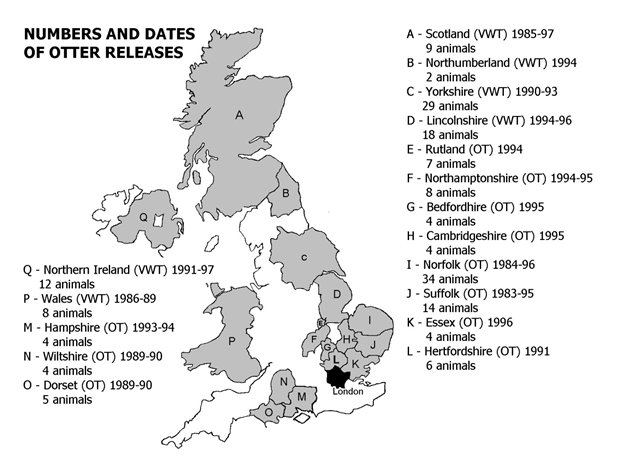 |
| Figure 1.
Numbers and Dates of Otter Releases.
(click for larger version) |
Breeding by Released Otters
Both organisations report that breeding by released otters occurs within 12-18 months of release. The OT has recorded 55 incidents of breeding from 36 release groups and subsequent generations to the end of 1996 (Wayre, pers.comm.). The VWT has recorded 26 families in North Yorkshire since the first release in 1990. Lincolnshire was recolonised by wild otters as the releases took place, so although 2 families born at release sites within the year were attributable to restocked animals, subsequent families were of unknown parentage. Expansion of range and influence on National Otter Survey results
-
East Anglia
In the first National Survey (1977 79) only 20 of 623 (3%) sites were positive. Norfolk was one of the few English otter strongholds left with 16 positive sites; a situation which worsened in the next few years. Suffolk and Lincolnshire had 1 positive site each and Cambridgeshire 2. Four groups, comprising 11 animals, were released before the second National Survey (1984 86). (Figure 2) In this survey only 8 of 725 (1.1%) sites were positive, of which 5 were attributed to released otters, (Strachan et al., 1990) showing that East Anglian otters were close to extinction. By the third National Survey (1991 94) (Figure 3) 37 otters had been released and 58 (8%) sites were positive, largely derived from otter releases, showing continued successful breeding and range expansion. Additional evidence for the success of the programme comes from the timing of the change from decline to resurgence of the Suffolk otter population which fits well with the beginning of the releases and also the high density of spraint found in release areas compared with the rest of south east England, (Strachan and Jefferies, 1996).
The Lincolnshire releases were too late to figure in the third National Survey, although the start of the concurrent recolonisation by wild otters was seen. Since then VWT surveys show rapid expansion on the rivers used for releases and others, including those rejected as releases sites because the habitat or pollution levels were considered unsuitable.
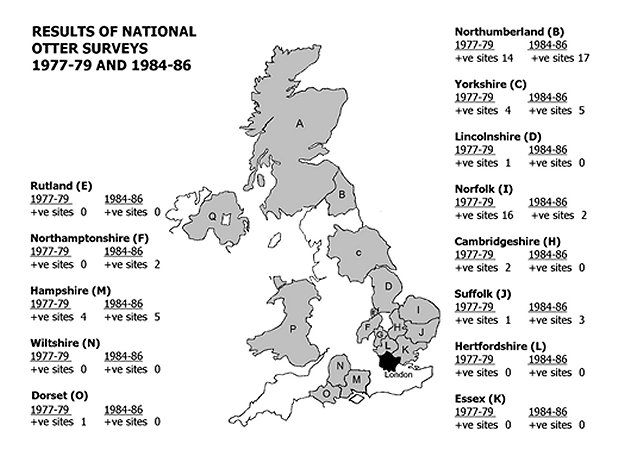 |
| Figure 2.
Results of National Otter Surveys 1977-79 and 1984-86.
(click for larger version) |
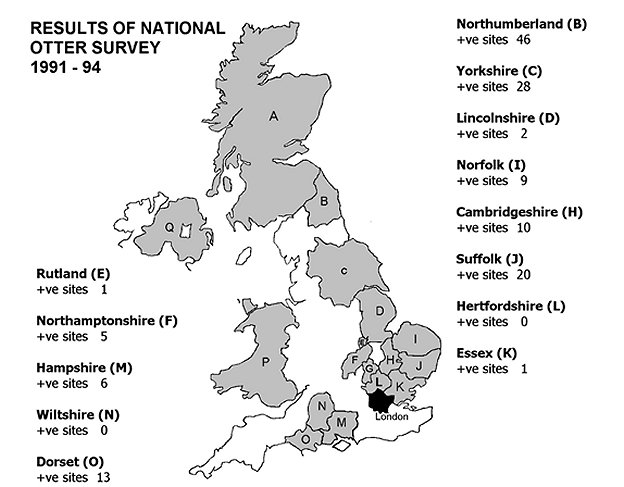 |
| Figure 3.
Results of National Otter Survey 1991-94.
(click for larger version) |
-
North Yorkshire
The large Derwent catchment had no positive sites on the first National Survey (1978) and only 1 on the second in 1985, (Figure 4) but on the third National Survey (1991-94), after the VWT releases, (Figure 5) 12 (75%) of sites were positive. Only 4 otters were released on the River Esk, in late 1993, but they were enough to increase positive sites on the river from 1 in 1986 to 3 in the 3rd National Survey. Unfortunately the English survey is done on a chequer board of alternate 50km squares and the main part of the Derwent catchment south of the Esk and north of the Pocklington Canal has never been surveyed. The surveyor concluded that the improved situation on the Derwent and to a lesser extent the Esk was wholly due to the restocking programme, (Strachan and Jefferies, op. cit.). Detailed work since the National Survey shows that otters have now spread to colonise the entire 2057 km2 catchment of the River Derwent (Woodroffe, 1996) and beyond. The whole 42km length of the River Esk is occupied by otters.
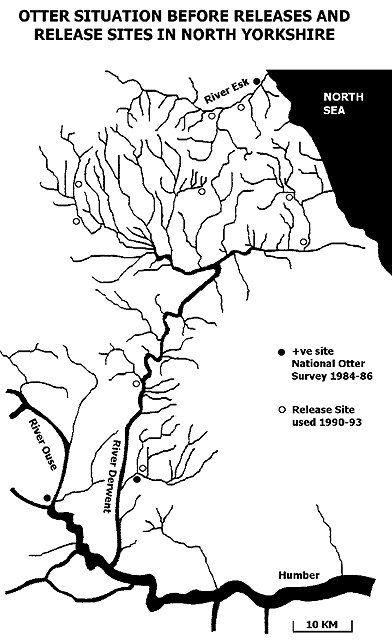 |
| Figure 4.
Positive sites for otters before release program began, and release sites in Yorkshire.
(click for larger version) |
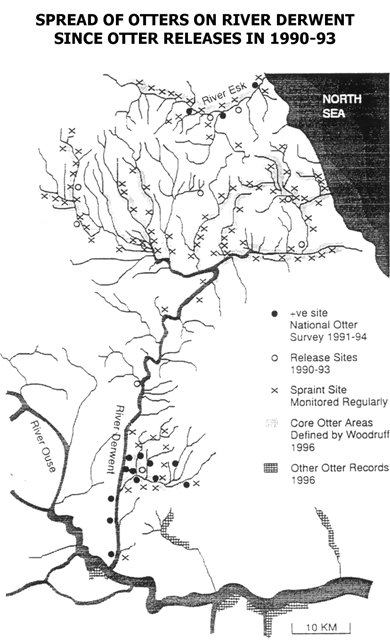 |
| Figure 5.
Spread of Otters on the River Derwent since the Otter Releases in 1990-93.
(click for larger version) |
Both areas have had enough population growth and expansion of range to show up in the broad sweep of the National Survey. That the population results from restocking is demonstrated by the isolation of the two populations, there was vacant territory to the west and between them. Although other parts of England showed increased site occupancy between the second and third National Surveys the rate of increase shown in the restocked areas was greater, e.g. East Anglia showed an increase of 552% compared to 40% in Southern Region and Yorkshire showed an increase of 400% after restocking compared to 25% before.
Other areas were restocked too late to figure in the National Survey results, already had a sparse otter population or were recolonised over the same time span, so their National Survey results are not as clear cut as those for East Anglia or North Yorkshire.
Otter Mortality in Restocked Areas
Identification of dead released otters is possible by reading their transponders. It is known that 3 males and 1 female from the VWT (5.1%) and 5 males and 2 females from the OT (6.8%) releases have died. Other deaths, of subsequent generations, the relict population or where the corpse could not be read also occurred. Known deaths in release areas total 24, with circumstantial evidence of 2 more. Corpses were postmortemed and analysed for contaminants whenever possible. Most were male (19), 5 were female and 2 not sexed. The most common cause is road traffic (15), followed by drowning in fyke nets (4), snaring (?2), injury by other otters (1) and 4 deaths for which the cause was not determined.
DISCUSSION
Criteria for determining success of restocking programmes are:
-
that the released animals survive and do not show unusually high mortality.
-
that a measurable,long term breeding population is established in the release area.
-
that the population expands from the release area.
Within the, so far, short time scale these criteria all appear to have been met in Britain.
Despite publicity requesting dead animals and considerable search effort, few tagged otters were found dead. In view of concern about contamination at release sites (Mason, 1991, 1992, 1995) their pollution load was of interest. No otters died of contamination, none had above average levels and known deaths were all from common and expected causes among wild otters. British results compare well with 16 known deaths in 36 animals released in Sweden (44.4%), (Sjöasen, 1996). Male deaths were more frequent in the Swedish study (10:6) also. British animals were not implanted with radio transmitters as in Sweden, so non-traumatic deaths are under represented in the British data. However, the youth of the Swedish otters (captive bred animals <12 months, wild animals c12 months) relative to the British animals undoubtedly played a part in their higher mortality. Sjöasen demonstrated that the length of maternal care affected subsequent survival; the least successful were separated from their mothers for 50-98 days before release, whereas those with a longer period of maternal care were as successful as wild animals.
Otters bred freely after release and breeding has continued; the time scale is long enough in some areas for second and third generation breeding to have occurred. Breeding was also observed in Sweden within the study period.
Populations have expanded and are continuing to do so. The concurrent expansion of the wild population makes long term measurement of the growth of restocked populations difficult, but shows that the programme is fulfilling its aims of aiding natural recolonisation and hastening its end point. In the British context restocking achieved its ends using comparatively few animals (149). However, the situation proved not to be as urgent as predicted; although parts of England lost otters, there were still strongholds from whence recolonisation could, and did, take place. Large scale reintroductions to vacant areas have not occurred. It is no longer policy to restock otters in Britain; the last VWT restocking was in April 1996 and the last OT animals are being released in 1997.
IMPLICATIONS FOR EUROPE
In the continental context, with a larger landmass and greater distances over which recolonisation would have to take place the scale of reintroduction programme necessary to make an impact may be greater than in Britain. Without strong, genetically similar populations to provide wild stock or orphans for rehabilitation, captive breeding on a large scale would be necessary to supply the programme. Captive breeding success has now been achieved at many centres in Europe. A wild population is a prerequisite for rehabilitation, but orphan cubs can be found occasionally in the most threatened population and are especially valuable for their genetic potential. Techniques for raising and successfully returning even the youngest hand reared cub are available, so the value of the wild born orphan should not be overlooked, either for breeding or release.
The results of the British and Swedish studies show that the length of maternal care is a significant factor in survival and that older otters may be more successful. The higher male mortality recorded by all studies (72.5%:27.5%) raises questions as to the numbers of males required in a release programme. This is a drawback of rehabilitated stock; more males (59%:41%) come in, more survive, so more are available for release (61.5%:38.5%). With concern over the effects of pollution and habitat degradation and no consensus as to minimum conditions for viable otter populations, groups of males could be used as probes to test the suitability of formerly polluted or degraded habitats for the species, (Caughley, 1994) while females are used for breeding.
Preparation for a reintroduction programme requires strict adherence to agreed criteria and protocols, but does have the advantage of producing more detailed data on the chosen habitat than would be obtained from routine otters surveys. In order to assess the programme it is essential to have co-ordination of releases and agreement of all parties on record keeping and monitoring. Given such agreement and co-operation, we are cautiously optimistic that the techniques tested in Britain could be applied as successfully in Europe.
REFERENCES
Caughley, G. (1994). Directions in conservation biology. J. Animal Ecol. 63: 215-244
Crawford, A., Evans, D., Jones, A. Mcnulty, J. (1979). Otter Survey of Wales 1977-78. Society for the Promotion of Nature Conservation, Nettleham.
Green, J. Green, R. (1980). Otter Survey of Scotland 1977-79. The Vincent Wildlife Trust, London.
Green, J., Green, R. Jefferies, D. J. (1984). A radio tracking survey of otters Lutra lutra on a Perthshire river system. Lutra (J. of the Otter Trust) 27: 85-145.
Lenton,E.J., Chanin, P.R.F., Jefferies, D. J. (1980). Otter Survey of England 1977-79. Nature Conservancy Council, London.
Mason, C. F. (1991). Otter reintroductions: does theory match practice? In: Reuther, C. and Röchert, R. (Eds.): Proceedings of the V. International Otter Colloquium. Habitat 7: 213-217.
Mason, C. F. (1992). Do otter releases make sense? The experience in Great Britain. In: Reuther, C. (Ed.): Otterschutz in Deutschland. Habitat 7: 157-161.
Mason, C. F. (1995). Impact of pollution on the European otter. Cahiers d'Ethologie 15: 307-320.
Mitchell Jones, A. J., Jefferies, D. J., Twelves, J., Green, J., Green, R. (1984). A practical system of tracking otters Lutra lutra using radio telemetry and 65Zn. Lutra (J. of the Otter Trust), 27: 71-84.
O'Connor, F. B., Chanin, P. R. F., Jefferies, D. J., Jenkins, D., Neal, E., Rudge, J., Sands, T.S., Weir, V., Woods, M. S. (1979). Otters 1979: A Second Report of the Joint Otter Group, Society for the Promotion of Nature Conservation, Nettleham.
Sjöasen, T. (1996). Survivorship of captive bred and wild caught reintroduced European otters Lutra lutra in Sweden. Biol. Cons. 76: 161-165.
Strachan, R., Birks, J. D. S., Chanin, P. R. F., Jefferies, D. J. (1990). Otter Survey of England 1984-86. The Vincent Wildlife Trust, London.
Strachan, R., Jefferies, D. J. (1996). Otter Survey of England 1991-94. The Vincent Wildlife Trust, London.
Woodroffe, G. (1996). Reinforcing the otter population in the Yorkshire Derwent a preliminary report. Internal report to the Department of Biology, University of York.
Previous | Contents | Next
|





